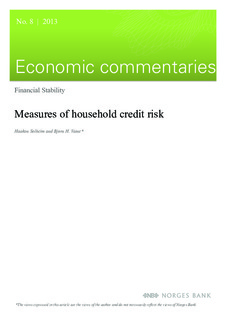| dc.contributor.author | Solheim, Haakon | |
| dc.contributor.author | Vatne, Bjørn Helge | |
| dc.date.accessioned | 2018-08-15T11:58:48Z | |
| dc.date.available | 2018-08-15T11:58:48Z | |
| dc.date.issued | 2013 | |
| dc.identifier.uri | http://hdl.handle.net/11250/2558133 | |
| dc.description.abstract | The default rate on loans to households by Norwegian banks and mortgage companies fell after the banking crisis in the 1990s and has been low since the turn of the millennium. We argue that credit risk arises in households that have high debt, low debt-servicing capacity and inadequate collateral at the same time. Even though debt burdens have risen to historically high levels, the share of debt held by households with poor debt-servicing capacity and low collateral has fallen since the beginning of the 1990s. However, the size of the vulnerable group will be sensitive to shocks, such as higher interest rates, lower purchasing power or a decline in house prices. | nb_NO |
| dc.language.iso | eng | nb_NO |
| dc.publisher | Norges Bank | nb_NO |
| dc.relation.ispartofseries | Economic Commentaries;8/2013 | |
| dc.rights | Attribution-NonCommercial-NoDerivatives 4.0 Internasjonal | * |
| dc.rights.uri | http://creativecommons.org/licenses/by-nc-nd/4.0/deed.no | * |
| dc.title | Measures of Household Credit Risk | nb_NO |
| dc.type | Others | nb_NO |
| dc.description.version | publishedVersion | nb_NO |
| dc.subject.nsi | VDP::Samfunnsvitenskap: 200::Økonomi: 210::Samfunnsøkonomi: 212 | nb_NO |
| dc.source.pagenumber | 5 | nb_NO |

